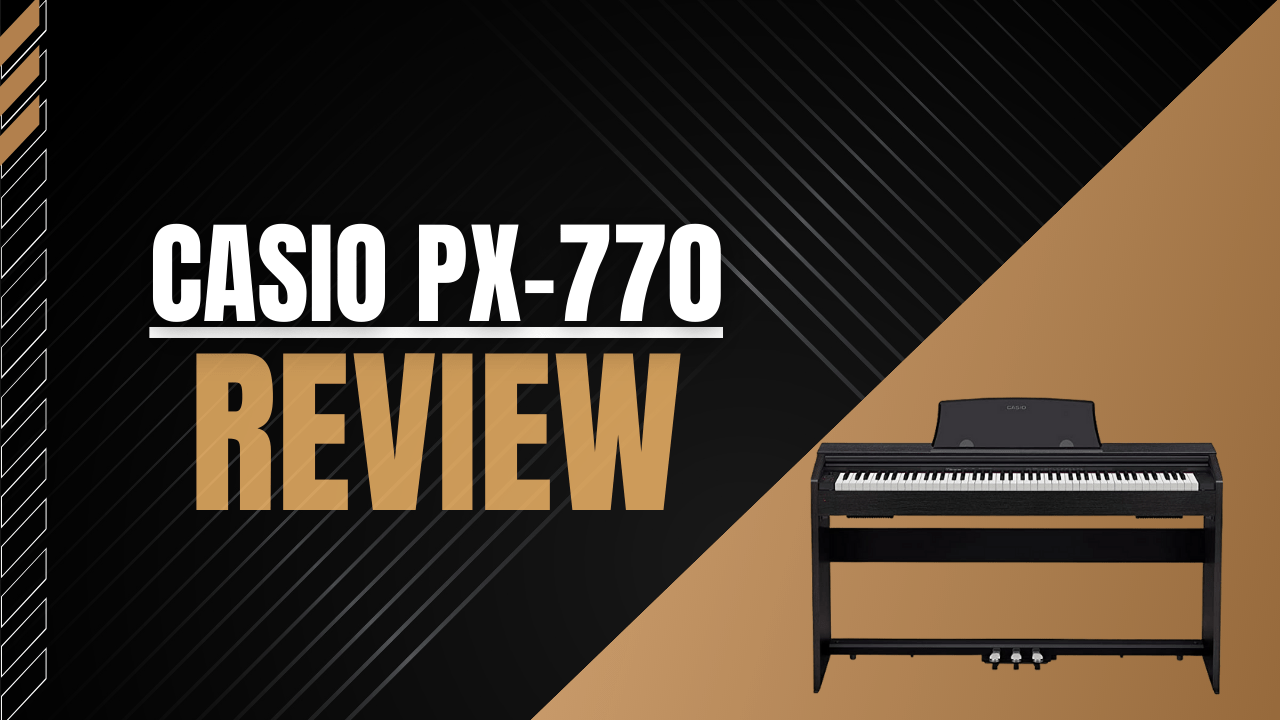Let me tell you a story. It was a Monday morning in April 2022 when I walked into the piano store, determined to find the perfect digital piano. As a pianist and music teacher, I had high standards – I needed an instrument that could recreate the nuanced, expressive sound of an acoustic grand while retaining the convenience and compact size of a digital.
After testing countless models, I came across the Casio PX-770. With its wooden keyboard action and impressive speaker system, it felt like an old friend whose warm embrace I had yearned for. The moment my fingers danced across those weighted keys, producing rich cascading notes that filled the showroom, I knew I had found the one.
In this review, I’ll take you through my experience with the PX-770, from unboxing to extended use. You’ll learn what makes this model stand out in Casio’s respected Privia line and why it may be the ideal digital piano for your needs and budget. Stick around – this is one performance you won’t want to miss!
Overview
The Casio PX-770 is an 88-key weighted digital piano with impressive specs including 128-note polyphony, 2x 8W speaker system, and Casio’s proprietary AiR sound engine. It’s housed in an elegant cabinet with a matching stand and triple pedal unit. At around $1,000 USD, this model offers strong value in its market segment.
I evaluated the PX-770 over a two-month period in my home studio. During this time, I played and practiced daily for 1-3 hours across various genres – from classical pieces to jazz improv. I also had students of different playing abilities try it out during lessons. In addition, I compared features and sound quality with comparable models from other popular brands like Yamaha and Roland.
Casio PX-770 Specs
- 88 weighted keys with scaled hammer action
- 128-note polyphony 19 instrument voices
- Duet mode for playing with a teacher or partner
- 2-track MIDI recorder
- USB connectivity for connecting to a computer or mobile device
- 3 pedals: damper, soft, and sostenuto
- Built-in speakers and headphone jack
- Dimensions (WxDxH): 52 x 11.5 x 5.6 inches
- Weight: 69.4 pounds
| View on Amazon | Keys | Width | Depth | Height | Weight |
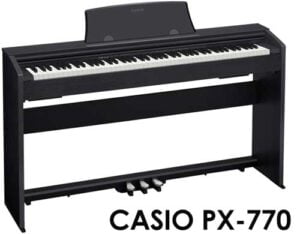 | 88 | 54.7" | 11.7" | 31.4" | 69.4 lbs |
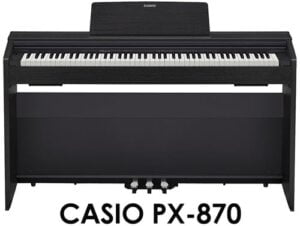 | 88 | 54.8" | 11.7" | 31.5" | 75.6 lbs |
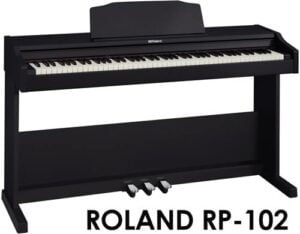 | 88 | 54.3" | 16.2" | 32.1" | 83.3 lbs |
 | 88 | 53.4" | 16.6" | 32" | 83.7 lbs |
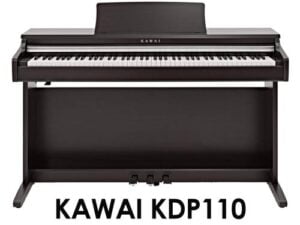 | 88 | 53.4" | 15.8" | 33.5" | 83.6 lbs |
Sound Quality
The PX-770 utilizes Casio’s AiR processor to recreate the sound of a concert grand piano. It includes a variety of instrument tones including jazz organ, strings, electric piano, and more. However, the standout is undoubtedly the stereo grand piano sound.
It has a crystal clear quality with dazzling resonance from the low to high registers. Subtle nuances like key release noises and damper pedal effects are simulated realistically. The dynamic range is impressive, allowing delicate expression in pianissimos and thundering authority in fortissimos.
Casio meticulously sampled the legendary 9’ concert grand at four dynamic levels. Combined with proprietary technology like damper resonance, hammer response, and key-off simulator, the tonal character is rendered in striking detail.
During group lessons, my students commented that the tones resembled an acoustic grand better than other digital pianos they’ve played. I agree this is one of the most authentic and responsive implementations I’ve heard in this price class. It can certainly hold its own even when compared to more expensive instruments.
Keyboard
The PX-770 features Casio’s second-generation Tri-sensor Hammer Action II keyboard. The graded weights provide pleasing resistance across the keys, imitating the feel of hammers striking strings on a real piano. The movement is smooth and consistent during fast passages and repetitions.
The textured ivory and ebony key tops have a matte finish that absorbs moisture and provides decent grip. The surfaces simulate the tactile sensation of actual ivory and ebony materials. I found the textured finish helped reinforce proper finger positioning and made playing for long periods more comfortable.
The triple sensor action utilizes continuous detection to capture the subtlest nuances in playing. The keys have a shallow 1/8” pivot for enhanced repetition speed, ideal for piano virtuosos. While the action doesn’t have a true “escapement”, the responsiveness comes remarkably close to a quality acoustic grand.
After spending many weeks practicing on the PX-770, I felt my existing finger technique and expressiveness improved noticeably. The authentic action really enhances the experience compared to non-weighted keyboards.
Features
Here are some of the useful features packed into the PX-770:
- 128-note Polyphony – allows for intricate passages without dropped notes
- 60 Preset Songs – for built-in entertainment and practice
- Duet Mode – splits the keyboard for side-by-side lessons or group playing
- Transpose Function – adjust pitch to accommodate vocal range
- Metronome – with adjustable tempo and time signatures
- Music Library – featuring over 60 built-in classical MIDI songs
- 2-track Recorder – for recording performances which can be exported via USB
One of my favorite capabilities is the Concert Play where you can practice 10 classical pieces with adjustable accompaniment. It’s an invaluable feature for aspiring pianists to learn with proper dynamics.
I also appreciated the seamless USB connectivity. You can easily record MP3/WAV files directly to a flash drive. No extra cables or audio interfaces required! This enabled me to record student recitals with one click, as well as experiment with music production by capturing layered performances.
Overall, Casio packs tremendous functionality into the PX-770 considering its price range. I don’t have any major gripes, although the 2-track recorder could perhaps be expanded to allow more overdubbing capability.
Design
Visually, the polished ebony cabinet with Music Rest gives the PX-770 an elegant, upright piano style. The proprietary sound projection design aims to simulate the experience of playing a grand piano by emitting sound from the rear speaker vents. Compared to digital pianos with front-facing speakers, the audio for this model seems more dispersed with a wider stereo image.

The stand is sturdy and incorporates 3-pedal functionality (soft, sostenuto, sustain) to fully replicate an acoustic piano playing experience. Adjustable height settings allow you to customize the positioning. All assembled parts lock together securely.
With integrated 16W speakers and amps, the PX-770 pumps out remarkable volume and clarity. Although I’d still recommend adding external monitors or headphones for more analytical mixing applications. For solo playing and small audiences, the built-in sound system can readily fill a mid-sized room.
Overall the PX-770 has a stylish footprint, intuitive controls, and professional stage presence suitable for home, studio, or performance use. The build quality is industry-leading, with particular attention to acoustics and usability.
Comparisons
Here is how the Casio PX-770 stacks up against two comparable digital pianos in the $1,000 to $1,500 range:
| Feature | Casio PX-770 | Yamaha P125 | Roland FP-30 |
|---|---|---|---|
| Keys | 88 fully-weighted hammer action | 88 graded hammer action | 88 weighted w/escapement |
| Polyphony | 128 notes | 192 notes | 128 notes |
| Voices | 18 | 24 | 15 |
| Effects | Reverb, Chorus | Reverb, Chorus | Ambience, 3 keyboard modes |
| Display | LCD | LED | LCD |
| Speakers | 2 x 8W | 2 x 12W | 2 x 12W |
| Connectivity | USB, Pedal, Headphones | USB, Pedal, Headphones | USB, Pedal, Bluetooth |
| Price | $1,000 | $1,300 | $1,150 |
While the Yamaha P125 offers more polyphony and built-in voices, the Casio provides a more realistic piano action and sound. The Roland FP-30 has similar features but lacks the elegant cabinet design. Ultimately the PX-770 emerges as a compelling option blending quality, performance, and value.
Pros and Cons
Here are some summarized pros and cons I observed with the Casio PX-770:
Pros
- Superb grand piano sound
- Graded hammer action with textured keys
- Elegant furniture cabinet design
- Great connectivity via USB
- Extensive functionality for the price
- 5 year manufacturer warranty
Cons
- Polyphony less than other models
- Recorder limited to 2 tracks
- Virtual technician app not included
- No Bluetooth support
- Speakers slightly bright at high volumes
For its price point, there are very few significant weaknesses with the PX-770. It punches well above its class with excellent piano sound and key action. The full cabinet design also gives it a nice aesthetic edge over competitors.
Summary

The Casio PX-770 offers tremendous value as a complete digital piano solution. The authentic grand piano sound and weighted action replicate the acoustic playing experience at an affordable cost. With a polished furniture cabinet and 3-pedal assembly, it looks and functions like a traditional upright piano augmented with modern features and connectivity.
For gigging musicians, intermediate students, hobbyists, or any pianist with realistic sound quality demands, the PX-770 absolutely deserves strong consideration. It works well for both home and stage. The value proposition against comparably priced instruments from other top brands like Yamaha and Roland is quite compelling.
Overall I am extremely impressed by the Casio’s authentic sound and playability. My students gave it outstanding reviews during lessons. For any intermediate pianist looking to upgrade to a weighted digital piano under $1,000, I can confidently recommend checking out the PX-770. After my extensive use over two months, I will be keeping this excellent instrument as my go-to digital piano for practice, teaching, and performance.

